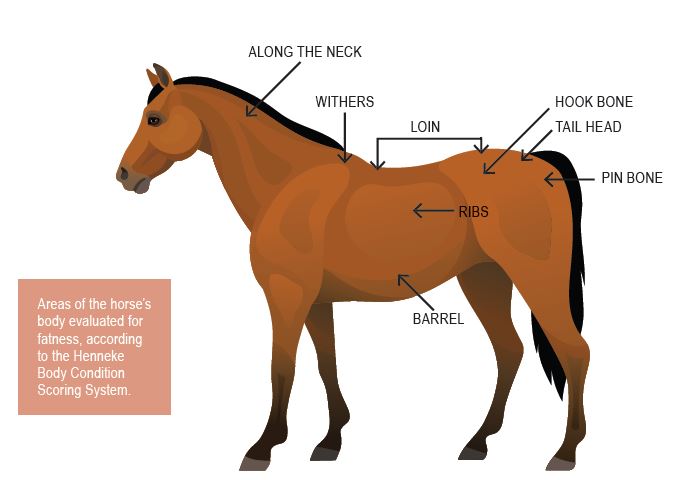Worried your horse is too heavy or thin? Here are a few easy ways to keep track of his weight to ensure he stays in good shape all year round.
Monitoring your horse’s weight is an important part of an overall management plan. Body condition scoring, while subjective, is an excellent tool for assessing overall fatness or lack thereof. More objective measurements, such as those taken with a weight tape or measuring tape, help give a general idea of the horse’s body weight. When body condition score and weight estimates are combined, you have the basis for tailoring a diet specific to your individual horse’s needs.
 Body condition
Body condition
The Henneke Body Condition Scoring System is a scale from 1–9 that evaluates fat cover and condition. A score of 1–2 is an emaciated horse (a veterinary emergency), 3–4 is considered thin, 5–6 is ideal, and 7–9 is considered obese (Henneke, et al, 1983; Dugdale et al, 2012). There are six areas on the horse’s body that are evaluated for fat (see chart below): the loin, ribs, tail head, withers, neck and shoulders.
Ways to weigh
In addition to keeping tabs on a horse’s body condition, it is also important to monitor his weight. A weight tape, placed around the horse’s barrel, directly behind the shoulders as he stands square, is an easy way to estimate weight (Photo 1). Measuring is important – you’ll often see changes in a measurement before noticing them visually. Weigh regularly – for example, on the first day of every month, or each time the horse’s hooves get trimmed. Keep a log so you can track weight fluctuations and adjust the diet accordingly.
A second way to estimate weight will require a soft tailor’s tape, about 100” to 120” long. Step one is to measure the horse’s barrel, or heart girth (HG) in inches, in the same manner as described above using the weight tape (Photo 2). Step two is to measure body length (BL) from the point of his shoulder to the point of his rump in inches (Photo 3). Plug the measurements into the equation that corresponds to your horse’s age:
- Horses over two years: (HG x HG x BL) / 330 = estimated body weight in pounds
- Yearlings: (HG x HG x BL) / 301 = estimated body weight in pounds
- Weanlings: (HG x HG x BL) / 280 = estimated body weight in pounds
General diet considerations for weight management
Although each horse should be fed as an individual, the need for forage is universal. Forage should make up no less than 50% of the entire diet, and ideally more (70% to 100%, depending on the horse’s needs). For horses with dental concerns, substitutes like soaked hay cubes, chopped forage and soaked beet pulp often work well to provide necessary fiber for gut health.
Some horses maintain their weight very well on forage alone. In this case, a ration balancer is recommended to ensure the horse receives vitamins, minerals and amino acids that may be absent in the forage source. Horses that have trouble keeping weight with forage alone typically require a moderate to high fat grain concentrate (6% to 14% crude fat), or a fat supplement, depending on their individual needs. Fat will help provide more calories with less grain. Overweight horses may need to have their forage intake restricted to 1.5% to 2% of their ideal body weight (for example, 15 lb to 20 lb/day for a horse that should weigh 1,000 lb). Even horses on a restricted diet should receive a ration balancer, as essential daily nutrients are still needed.

For horses with metabolic concerns such as Equine Cushing’s Syndrome or Equine Metabolic Syndrome (EMS), and that need to gain weight, a diet high in fat and fiber, and low in sugar and starch (also known as non-structural carbohydrates) is ideal. Select a grain concentrate with no more than 12% to 14% non-structural carbohydrates that contains 8% to 14% fat. If you are unsure of the non-structural carbohydrate content, contact the manufacturer. Pasture may need to be limited with a grazing muzzle, or opt to turn the horse out on a dry lot. Hay may need to be soaked to reduce dietary non-structural carbohydrates. Soaked hay, a high-fat, low-sugar and starch grain ration plus an additional fat supplement (if needed) often suits metabolic horses well. Metabolic horses that need to lose weight often do well on moderate quality forage and a ration balancer.
Summary
Weighing and body condition scoring your horse regularly will allow you to know what’s normal, and note any changes throughout the year. Schedule a check-up with your veterinarian at least once a year. If you’re not sure whether your horse needs to gain or lose weight, contact a qualified equine nutritionist or ask your vet for help. An equine nutritionist can assist in recommending a diet that ensures vitamin, mineral, protein and calorie needs are met. With proper weight monitoring and management, you’ll set your horse up to thrive!
Resources
Dugdale, A., Grove-White, D., Curtis, G., Harris, P., Argo, C. 2012. Body condition scoring as a predictor of body fat in horses and ponies. The Veterinary Journal. 194(2): 173-178.
eXtension.org, Winter Care for Horses. https://horses.extension.org/pages/25673/winter-care-for-horses
Henneke, D.R., Potter, G.D., Kreider, J.L., Yeates, B.F. 1983. Relationship between condition score, physical measurements and body fat percentage in mares. Equine Veterinary Journal. 15(4):371-372.
National Research Council 2007. Nutrient Requirements for Horses, 6th Edition. National Academies Press, Washington, DC.








